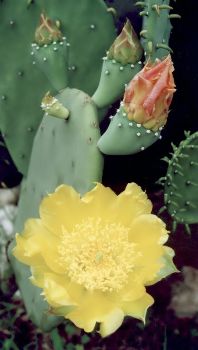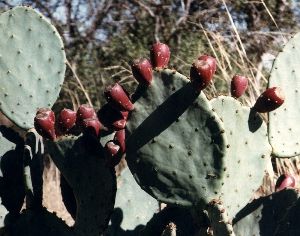Prickly Pear Cactus
by Valerie (May 23, 2000)
revised August 23, 2003
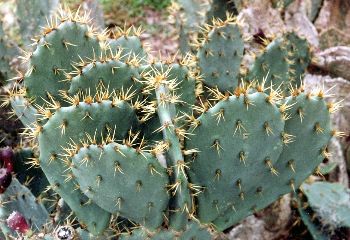 The prickly pear cactuses (Opuntia sp.) are familiar to just about everyone since they are very common and grow in a variety of climates. When I was growing up, we had a species in Illinois that did just fine spending several months under the snow each year. Of course, they grow all through the hot and dry areas of the southwest, but they also grow right along the coast, seeming to be able to handle the salt quite well. A lot of the species and varieties are fairly cold-hardy, which is certainly not the case for most cactuses. The prickly pear cactuses (Opuntia sp.) are familiar to just about everyone since they are very common and grow in a variety of climates. When I was growing up, we had a species in Illinois that did just fine spending several months under the snow each year. Of course, they grow all through the hot and dry areas of the southwest, but they also grow right along the coast, seeming to be able to handle the salt quite well. A lot of the species and varieties are fairly cold-hardy, which is certainly not the case for most cactuses.
There are lots of species of cactus that fall into the category of prickly pear. They all have flattened, oval or round stems that connect in sequence as the plant grows and are members of the Opuntia genus. They are closely related to the chollas, which are also cold-hardy and do well in this area. Aside from the basic similarities, these cactuses have a wide variation in size and habit. Some of the delicate, small forms never get much bigger than a few inches, while other types grow to be giants, and some plants are sprawling and hug the ground while others grow upright and compact. Even some of the prickly pear species have a number of very different forms, with the shape of the plants varying considerably. Growing wild in this area of TX are types that have very thick, long spines, some with almost no spines, just bristles, and a kind that grows very elongated and flattened. The picture at right is of this last type and was photographed on a ranch near Waco. There were several of these plants and they were all huge, the biggest being at least 20 feet in diameter and towering 6 to 7 feet tall.
While we grow a few small to medium sized plants for their ornamental value, the cactuses get to be quite a problem for area ranchers, where they can cover fields by the acre, their spines keeping hungry cattle at bay.
Although the flowers of most prickly pears are yellow, there are also red and bi-colored blossoms. We have two spineless prickly pears growing in a dry, sunny area of our yard and these produce lovely red buds which open into bright yellow flowers.
One of the main features of these cactuses is their edibility. The pads are eaten as well as the fruits from which the plants get their name. Here in Austin, both pads and fruit are sometimes available in the grocery stores. The fruits are eaten raw, made into jellies and preserves or pickled, while the pads are fried or cooked as a vegetable. |
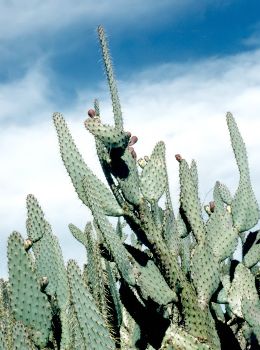
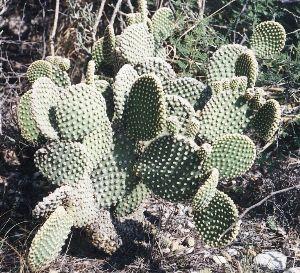 The cactuses propagate easily: any fallen pad will take root and become a new plant. When started from seed, the cactus does not acquire its characteristic shape until it is a couple of years old; the first stems are cylindrical and not flattened.
The cactuses propagate easily: any fallen pad will take root and become a new plant. When started from seed, the cactus does not acquire its characteristic shape until it is a couple of years old; the first stems are cylindrical and not flattened.
